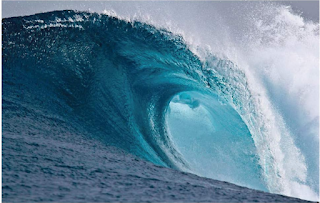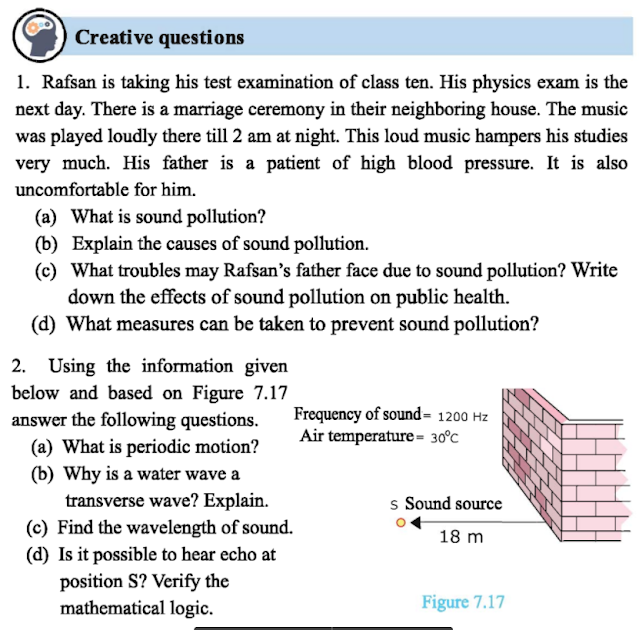Waves & Sound
Chapter- 7
Physics
1. What is wave?
Ans: The disturbance or variation that transfers energy progressively from point to point in a medium is called a wave. Wave is an oscillatory motion that transports energy from one location to another but does not move the particles in the medium permanently.
2. What is sound?
Ans: Sound is an energy. Sound is a vibration that typically propagates as an audible wave of pressure, through a transmission medium.
3. What is oscillation?
Ans: Oscillation is defined as the to and fro motion of an object from its position.
4. Show that a wave can bring the energy from one place to another places.
Ans: When a boat passes through the middle of a river, the waves created by it travel to the bank of the river. So, definitely energy is transferred through the wave. Besides, when we speak, the sound wave transfers sound energy from the speaker to the listener. From these examples, it can be said that a wave can bring energy from one place to another place.
5. Why is sound produced in whistle?
Ans: The main reason of the production of sound is vibration when the whistle is blown, it produces vibration in the air. If the frequency of vibration is more than 20 Hz, sound can be heard.
6. “When a wave propagates, the medium does not flow. It executes simple harmonic oscillation about its position”, true or false?
Ans: True. When a boat passes through a river, the waves created by it travel to the bank of the river. But water hyacinth or floating objects of the river just vibrate remaining in the same position. From this, it can be understood that the medium does not flow when a wave propagates. It executes simple harmonic oscillation about its position.
a) Periodic motion refers to the motion of a particle in such a way that it passes through a definite point along the path of its motion in the same direction in a definite interval of time.
b) Transverse wave indicates that the direction of motion of the particles is perpendicular to the direction of propagation of the wave.
Water wave is transverse wave because the direction of motion (vibration) of the particles of water is perpendicular to the direction of propagation of the waves of water.
c) Given,
Frequency of sound , f = 1200 Hz
Temperature of air = 3o०С
Let us suppose, velocity of sound in air at a temperature of 30 is v.
We know, the velocity of sound in air at a temperature of 0०С is 332 ms¯¹ and it increases by 0.6 ms¯¹ with an increase in temperature by 1०С.
Velocity of sound in air at a temperature of 30०С
= v = 332ms¯¹ + 0.6 ms¯¹ x 30
= 350ms¯¹
We also know that, v = fλ
or, λ = v/f
= 350 ms¯¹/1200Hz
= 0.2917 m
= 29.17 cm Ans.
d) Whether it is possible to hear echo at position S depends on the minimum distance between S and the reflector. If the distance (d) exceeds 18 m, echo cannot be heard; but if it (d) ranges up to 18m, echo can be heard. We have already found out that velocity of sound in air at a temperature of 30 ०С is 350 ms¯¹.
Since an echo implies twice the distance between the source of the sound and the reflector,
v = 2d/t
2d = vt
d = vt/2
Here,
v = 350 ms¯¹
t = 0.1 s ( the minimum time for taking place of an echo)
So, d = 350 ms¯¹ x 0.1 s / 2
= 35 m /2
= 17.5 m
This distance is less than the distance between the source and the reflector. It is therefore, possible to hear echo at position S.
7. Why is sound produced in a thunderstorm?
Ans: The main reason of production of sound is vibration. During thunderstorm, collisions between clouds occur. As a result, nearby layers of air vibrate which produces sound.
8. What problem would arise for a bat if it creates infra-sound instead of ultra-sound when flying?
Ans: Firstly, bat cannot hear infra-sound. A bat would face problems in detecting objects even if it could hear infra-sound. Because, the wavelength of infra-sound is very large. As a result, sound would not be reflected from thin or tiny objects. For these reasons, a bat would face problems if it creates infra-sound instead of ultra-sound when flying.
9. What is phase?
Ans: The overall condition of motion of a wave at any moment in time is known as its phase.
10. What is intensity of sound?
Ans: Intensity is the amount of sound energy flowing per second per unit areas perpendicular to the direction of propagation of sound waves.
Q. Hang a stone of mass 10gm from a string 1 m long. What is its time period?
Ans: T = 2 π√l∕g
= 2 π√l∕9.8 S
= 2.0 S
The time period remains the same whether the mass of the stone is 10gm or not.
Q. What is equilibrium condition?
Ans: If a mass is attached to the lower end of a spring, the mass will extend the spring end. This extended length of the spring is called the equilibrium condition.
Characteristics of Waves:
i) For mechanical waves a medium is necessary. Waves can be created in the water, a wave can be transmitted in the spring, a wave can be created in a rope. The sound we hear is also a wave and its medium is air.
ii) When a wave propagates through a medium, the particles of the medium oscillate about its own position but are not displaced permanently with the wave.
iii) Energy can be transferred from one place to another through waves. The more the energy, the more the amplitude of the wave. Energy is proportional to the amplitude is doubled, energy is increased four times.
iv) Every wave has a velocity; this velocity depends on the nature of the medium.
v) Reflection or refraction occurs for waves.
11. What does velocity of sound wave depend on?
Ans: Sound wave length depends on -
I) Type of medium
ii) temperature of the medium
iii) humidity of the medium
The intensity of sound is proportional to the square of the amplitude of the wave.
Types of Waves:
12. Why do bats not fly during the daytime?
Ans: Bats can produce and hear sound of frequencies ranging from 1kHz – 100 kHz (ultrasound). They fly using the echo of sound as they cannot see; this is why bats do not during the daytime.























